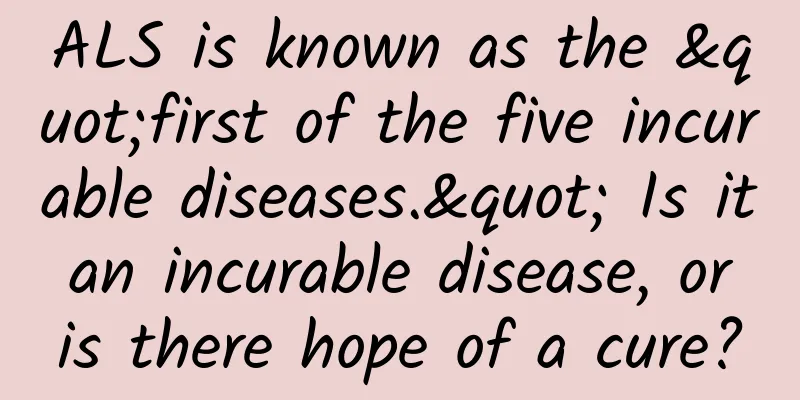ALS is known as the "first of the five incurable diseases." Is it an incurable disease, or is there hope of a cure?

|
Introduction In the past two years, ALS has become widely known to us. Cai Lei's story of fighting ALS has touched everyone and made us realize how terrible ALS is. Although he has tried many therapies, set up laboratories, read papers, and even initiated drug research, he still has not found a cure for ALS. This time, we invited Professor Jiang Haishan, an expert in the field of ALS and deputy chief physician of Nanfang Hospital of Southern Medical University, to help us understand how ALS imprisons life step by step? Why is the treatment of ALS so difficult? What are the existing treatment and rehabilitation methods? Professor Jiang serves as a member of the Neuromuscular Disease Group of the Neurology Branch of the Chinese Medical Association and a standing member of the Neuroscience Professional Committee of the Chinese Association of Research Hospitals. He has rich experience in ALS research. Jiang Haishan (Deputy Chief Physician, Nanfang Hospital Affiliated to Southern Medical University) | Guest Ye Shuisong | Interview Classification of motor neurone diseases Q: ALS is a type of motor neuron disease. Can you tell me what are the common motor neuron diseases? Jiang Haishan: Generally speaking, there are many types of common motor neuron diseases. The most common subtype is called "amyotrophic lateral sclerosis." Amyotrophic lateral sclerosis refers to changes in lower motor neurons, while lateral sclerosis generally refers to changes in upper motor neurons, so "amyotrophic lateral sclerosis" means that both the upper and lower sides are "affected" at the same time. In addition, there is pure upper motor neuron involvement, which we call "primary lateral sclerosis"; there is pure lower motor neuron involvement, which we call "progressive spinal muscular atrophy"; and there is also involvement of the motor neurons in the brainstem, which we call "progressive bulbar palsy." These are the four most common types. But in fact, there are many types that progress slowly, such as the common type that mainly affects the cervical segment (motor neuron disease). This type of disease is limited to the cervical segment for more than one year, which we call "flail arm syndrome". There is also a type that mainly affects the lumbar sacral segment for more than one year, and other parts are not affected much, which is called "flail leg syndrome". In addition, there are some very special types, such as Mills syndrome, which mainly affects half of the limbs and is limited to half of the limbs for more than one year. Q: How does ALS differ from other motor neurone diseases? Jiang Haishan: In fact, ALS is the general name for motor neuron diseases. At the beginning, the name was different in different regions. The term ALS was not first used in mainland China, but was first named by Taiwan, China. However, because this term is very vivid, it has gradually been accepted by everyone. At first, we called this disease motor neuron disease, but the term motor neuron disease is more professional and not vivid enough. On the contrary, "amyotrophic lateral sclerosis" is very vivid. Therefore, motor neuron disease has many names, and amyotrophic lateral sclerosis is just one of them. Causes and Pathogenic Genes of ALS Question: Are the causes of ALS different? Jiang Haishan: There are actually many causes of ALS, which can be divided into two main categories: the first category is familial (fALS) - familial amyotrophic lateral sclerosis, or it can be called familial motor neuron disease; there is also a large category called sporadic motor neuron disease (sALS). At present, one of the earliest research papers on this disease in our country is an epidemiological survey conducted by Professor Shang Huifang of West China Hospital: the study shows that the proportion of sporadic motor neuron disease patients with gene mutations is about 11.1%, and the proportion of gene mutations in those with a family history of the disease is about 55%. This means that even if you have a family history of ALS, the gene may not be screened out. Even for sporadic patients, there is still an 11.1% chance of screening out gene mutations. Many years ago, our center began to use whole-genome sequencing for testing. In fact, we found that people with a family history have gene mutations of 80% or more than 90%. There are also some special mutations. For example, we found that a family could not find a suspicious gene through whole-genome sequencing, but later found a suspicious gene. We are also doing some related verification. But for sporadic patients, according to our existing data, 40% of people have gene mutations. Question: Teacher Jiang, can you tell us which are the common genes that cause ALS? Jiang Haishan: The most common gene that causes ALS is the SOD1 gene. But the first thing we discovered was actually some other gene mutations. Different experts and teachers in our country have written articles on the epidemiological investigation of gene mutations. We found that perhaps due to regional differences, the gene mutations in each place may be different. For example, in the southern region, SETX gene is relatively common. In our center, there are many gene mutations such as NEK1, TBK1, SQSTM1, and TARDBP, which are not common in many other places. In general, the SOD1 gene mutation may rank first in the world, which may be the most common gene mutation in the world. Q: Can you introduce these sporadic cases? What are the causes? Is it related to genes, or is it related to the acquired environment and our eating habits? Jiang Haishan: In fact, even if motor neuron disease is affected by gene mutation, it will also be affected by multiple factors such as the environment. We found that the incidence of motor neuron disease has increased significantly after the COVID-19. Patients with sporadic ALS may face a variety of triggers, including stress infection, anxiety, depression, etc. Therefore, long-term anxiety may cause a series of corresponding physiological changes, which in turn induce changes in the body. We believe that the main initiating factor of ALS is inflammation, which is not only caused by infection, but also by other factors, such as COVID-19 infection or long-term mental stress. These factors may induce an inflammatory response in the body, which in turn leads to protein denaturation and eventually ALS. The pathogenesis of ALS is very complex, involving common genes such as SOD1, some sporadic unknown genes, and the interaction between environmental factors and genes. Such complexity leads to the emergence of different cases. How ALS causes loss of mobility Q: ALS is also known as a chronic, progressive neurodegenerative disease. Can you explain how it affects our muscle capacity through neuropathy until the patient is unable to move? Jiang Haishan: Actually, this mainly involves the question of how our motor units are formed. First, we have neurons. The instructions formed by neurons are transmitted through nerve conduction, transmitting signals to the neuromuscular junction, and then acting on the muscles, which constitutes the entire motor unit process. When neurons degenerate, that is, when the "highest command" has problems, it cannot generate commands, which leads to corresponding lesions in the parts below the neurons that directly reach the muscles, such as nerve roots, axons, and neuromuscular junctions. Therefore, when we perform electromyography, we can observe a progressive decrease in the CMAP amplitude of motor nerves in patients with motor neuron disease. As the lesion progresses, neuronal degeneration proceeds downward, which can also lead to changes in the neuromuscular junction. We can usually observe degeneration similar to the cribriform plate when performing neuromuscular junction imaging, which is also a secondary change of motor neuron disease. Previously, Professor Cui Liying from Union Hospital specifically reported on this change that occurred in patients with motor neuron disease during repeated electrical stimulation. Unlike our common neuromuscular contact diseases such as myasthenia gravis, myasthenia gravis usually has return waves because its essential problem is the reduction of vesicles or mediators, while motor neuron cribriform plate disease does not show obvious return wave characteristics. As the disease progresses further downward, it will involve the entire muscle. If the muscle loses its superior innervation, disuse atrophy will gradually occur, and then the muscle will gradually atrophy. In addition, if there are other secondary changes, such as insufficient muscle energy supply and adaptation problems, some related lesions may also occur. Therefore, in general, the damage to the motor neurons is the root cause, and once damaged, it will trigger a series of lesions. As for why we should pay attention to diseases like ALS, I would like to say that it is a rare but serious neurological disease that has a huge impact on the quality of life of patients and their families. This is not only a concern in the medical field, but also an important issue that all sectors of society should pay attention to. Why should we care about ALS? Question: How many people are suffering from the disease in our country at present? Jiang Haishan: Our country currently lacks abundant epidemiological survey data. But in general, the prevalence rate is about 2/100,000-4/100,000, and the data reported by each person is also different. Therefore, we are very much looking forward to the formation of a complete epidemiological survey data in China in the future. At present, work in this area needs to be further promoted. From this perspective, according to the ratio of 4/100,000, there may be about 200,000 to 300,000 patients in my country, which constitutes a fairly large group. However, due to the severity of this disease, it is called "the first of the world's five terminal illnesses" and has a very high mortality rate, usually between 3 and 5 years. If the patient does not receive standardized treatment, life may come to an end in just 3 to 5 years, so a lot of care follow-up is required in this case. We are faced with a grim fact that the prevalence should theoretically be higher than the incidence. However, we found that the prevalence and incidence are similar, which may be due to the fact that many new patients each year reach the end of their lives in a short period of time, resulting in little difference between the prevalence and incidence. Of course, this conclusion may require more epidemiological survey data to support it. Although the incidence of this disease is relatively low in my country, due to the large population base in my country, the patient population is still quite large overall. Question: What is the approximate age of onset of ALS in our country? Jiang Haishan: The onset of ALS mainly depends on whether it is familial or sporadic. If it is sporadic, there are generally more patients in the group over 50 or 60 years old. If it is hereditary, it depends on which mutation it is. The four most common early-onset genetic mutations include: SOD1, SETX, ALS2 and FUS genes. Among the patients with early onset, the youngest ALS patient I have ever treated was 1 year old, and his mutant gene was ALS2. In contrast, genes like SOD1 usually develop in the 20s or 30s or 30s, SETX genes develop in adolescence around 10-19 years old, and FUS genes develop in the 20s or 30s. Therefore, the age of onset of ALS is closely related to its cause. Whether it is a familial case of gene mutation, a sporadic case, or even a case affected by certain predisposing factors, it will have a certain impact on the onset time. Q: Is there any difference between men and women with ALS? Jiang Haishan: According to the data from our center, the difference in the proportion of male and female patients is not particularly large. Although some literature reports that there are more male patients, the data from our center basically shows no obvious gender difference. Question: How long is the average survival period of a patient? Is it closely related to the cause of the disease? Jiang Haishan: Both the age of onset and the course of the disease are closely related to the specific cause. Each cause is different, and some causes will progress faster. We know that once SOD1 patients are activated, they progress relatively quickly; there are some genetic factors, such as SETX, which progresses relatively slowly; for some acquired causes, sometimes it depends on whether the patient is actively intervened after the onset of the disease, and whether the anxiety and depression affect his entire treatment process after the onset of the disease. In addition, the degree of family support is also an important intervention factor in the length of the patient's disease course. Therefore, the course of the disease may also be related to the treatment of each patient. For example, your long-term anxiety and depression may be a cause of it. In addition, for the treatment of ALS, standardized treatment can slow down the progression of the disease. A typical example is the famous physicist Stephen Hawking. When he was diagnosed with ALS in his 20s, the doctor told him that he would only have one year to live at most, but Hawking eventually lived to be 76 years old, extending his life by 50 years. The latest research progress on ALS Q: What progress and breakthroughs have been made in the research on ALS in recent years? Jiang Haishan: With the participation of more and more doctors and scientific researchers, the development of the field of ALS has gradually shown a clear outline. We are carrying out early, mid-term and late-stage preparations, involving the introduction of drugs, research on drug mechanisms and in-depth discussions on the pathogenesis. We are closely connected and cooperating with outstanding domestic experts. At the same time, the rapid development of the current field of mechanism research, as more and more researchers join, will promote the further expansion of this disease field. We would like to especially thank Cai Lei for his important role in promoting it. We have done a lot of related work, hoping to live up to the trust of patients with motor neuron disease and strive to conquer this rare disease as soon as possible. Q: What treatments do you think are most promising? Jiang Haishan: There are several aspects of the most promising treatments: First, when patients first begin to show obvious symptoms in the early stages, some inflammatory modifications are more likely. We are now exploring new uses for old drugs, which can even delay the progression of the disease in the early stages of the disease. In addition, inflammation may occur during the onset of the disease, inducing protein folding in the body, and then inducing a cascade effect. Therefore, drug treatment that interrupts this cascade effect will also be very important. In addition to that, there are also later stage deliveries, which are treatments that we also feel are very promising. At present, we are also working on this aspect, but the specific treatment method is still blank, and many things have not yet produced results. The drug clinical trial we are currently conducting is to interrupt a very important target in the cascade effect. But whether it will work or not, we are also waiting to see. This article is a work supported by Science Popularization China Starry Sky Project Team/Author: Deep Science Reviewer: Miao Zhongrong Director of Neurointervention Center, Beijing Tiantan Hospital, Capital Medical University Produced by: China Association for Science and Technology Department of Science Popularization Producer: China Science and Technology Press Co., Ltd., Beijing Zhongke Xinghe Culture Media Co., Ltd. |
>>: How come your butt has hemorrhoids?
Recommend
What foods can supplement progesterone
What can I eat to increase my progesterone levels...
Can I eat lobster if I have uterine fibroids?
It is well known that after suffering from uterin...
Why does my lower abdomen hurt after sex?
Sexual intercourse should be an act that can brin...
Can you get pregnant with adnexitis?
After getting married, women should still maintai...
How to treat corpus luteum atrophy
Corpus luteum insufficiency is an ovulatory menst...
Picture of urethral eversion
Conditions such as redness, swelling and eversion...
How to use long-term contraception after giving birth to a second child
With the opening of the two-child policy, more an...
Is it B-ultrasound or vaginal ultrasound to monitor ovulation?
Nowadays, women begin to actively check their ovu...
Does yellow peel fruit cause internal heat? How to clean yellow peel fruit
Huangpi fruit is rich in nutrition. Eating some H...
I have had bacterial vaginitis.
In life, many women are familiar with bacterial v...
Women's morning urine has an odor
If a woman's morning urine has an odor, there...
Does medical abortion affect pregnancy?
Sometimes children may be born at the wrong time,...
Abnormal PH value of vaginal discharge
Clinically, the pH value of leucorrhea can be tes...
What medicine can I take to stop my menstrual period?
There are many reasons for irregular menstruation...
How to wear underwear when your breasts are enlarged
For women who love beauty, breasts are naturally ...









